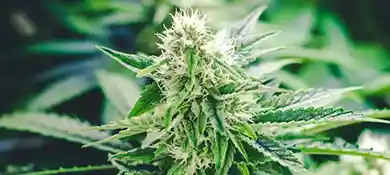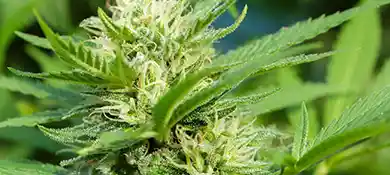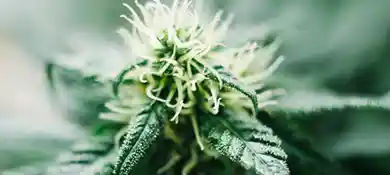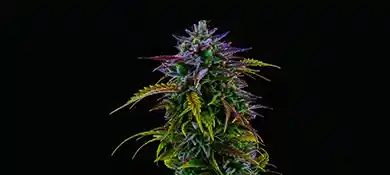6 Ways to Avoid White Spots on Fan Leaves During Flowering
Are you tired of seeing pesky white spots on fan leaves during flowering, affecting your precious marijuana plants? Worry no more! In this blog post, we'll explore solutions to eliminate those annoying white spots, ensuring a healthy and bountiful harvest.
With our expert guidance, you'll be well on your way to vibrant, spot-free fan leaves and a successful growing experience. Read on to discover the ultimate remedies to this common problem!
White spots on fan leaves during flowering can be a significant concern for any marijuana grower. This comprehensive guide will explore the causes behind these unsightly spots and provide proven solutions to overcome them.
Say goodbye to white spots and hello to a thriving, bountiful harvest. Read on to uncover the secrets of healthy marijuana plants, free from white spots on their fan leaves!

Unraveling The Reasons For White Spots On Fan Leaves During Flowering
There are several reasons why white spots can appear on fan leaves during marijuana flowering. Some of the most prevalent causes include:
Nutrient Deficiencies
Plants need a balance of essential nutrients to grow and thrive, and insufficient amounts can lead to various deficiencies. For instance, a calcium deficiency can result in white spots on fan leaves. Other nutrient deficiencies that can lead to white spots include magnesium and zinc.
Nutrient Overabundance
Conversely, having too much of certain nutrients can also result in white spots on fan leaves. An excessive amount of phosphorus or potassium, for example, can cause white spots to appear.
Pests And Diseases
White spots on fan leaves might also indicate pest infestations or plant diseases. Pests like spider mites, thrips, and fungus gnats can cause leaf white spots. Plant diseases such as powdery mildew can also lead to the development of white spots.
Environmental Stressors
Environmental factors like high humidity, low temperatures, and excessive light can cause white spots on fan leaves. For example, if the humidity is too high, it can lead to the development of fungal spores, which can result in white spots.
Identifying White Spots On Fan Leaves During Flowering: A Closer Look
When you spot white marks on fan leaves during marijuana flowering, it's vital to determine the cause as soon as possible. Here are some methods to help you identify the issue and address it effectively:
Visual Symptoms
Look for white spots on the fan leaves of your plants. Also, pay attention to other visual symptoms like yellowing or wilting leaves.
Inspecting the Plant
Check the plant for any signs of pest infestations or diseases. For example, look for spider webs, droppings, or any signs of mold or mildew.
Solutions and Prevention for White Spots on Fan Leaves
After determining the cause of white spots on fan leaves during flowering, addressing the problem and preventing it from reoccurring is essential. Here are some solutions and preventive steps to consider:
Balancing Nutrient Levels
If nutrient deficiencies or excesses are causing the white spots, adjust the nutrient levels accordingly. For example, use a well-balanced fertilizer and ensure your plant receives the nutrients it needs.
Addressing Pests and Diseases
Treat your plant with suitable insecticides or fungicides if pests or diseases are behind the white spots. Always follow the manufacturer's guidelines and use only approved products.
Controlling Environmental Factors
If environmental stressors are causing the white spots, take steps to manage the environment better. For example, maintain proper temperature and humidity levels, and avoid excessive light exposure.
Preventative Measures for Future Grows
To prevent white spots from occurring in the future, practice good hygiene and sanitation. Ensure your grow room is clean and sterile, and avoid overwatering your plants.
Proactive Measures to Avoid White Spots on Fan Leaves During Flowering
Preventing white spots on fan leaves during flowering is crucial for healthy plant growth. Here are some helpful tips to keep this issue at bay:
- Sustain ideal growing conditions, including temperature, humidity, and light levels.
- Regularly inspect your plants for any signs of pests or diseases.
- Apply a preventive fungicide or insecticide before any problems arise.
- Ensure proper spacing between plants to promote good air circulation.
- Utilize high-quality soil or hydroponic medium that offers excellent drainage and nutrient content.
- Avoid overfeeding or underfeeding your plants.

Common Cannabis Growth Challenges and Their Solutions
Below are a few other typical problems that growers may face during different stages of marijuana growth, along with their causes and potential remedies:
Hindered Growth in the Vegetative Stage
Hindered growth during the vegetative stage can result from various factors, including nutrient deficiencies, over or under-watering, extreme temperatures, and inadequate light. To tackle this issue, adjust and maintain proper nutrient levels, ensure appropriate watering and drainage, keep the temperature within the optimal range (70-85°F), and provide sufficient lighting.
Leaf Yellowing in the Vegetative Stage
Leaf yellowing during the vegetative stage may be caused by nutrient deficiencies (e.g., nitrogen, magnesium), overwatering, pH imbalances, or root damage. To address this issue, fine-tune nutrient levels, maintain proper watering and drainage, monitor pH levels, and examine roots for any signs of damage.
Stretching during the Early Flowering Stage
Stretching during the early flowering stage can be caused by insufficient light, genetics, high temperatures, or overfeeding. To solve this problem, adjust the lighting to provide more intensity or duration, choose strains that are less prone to stretching, maintain optimal temperature range, and reduce nutrient levels.
Bud Rot during Late Flowering Stage
Bud rot during the late flowering stage can be caused by high humidity, poor air circulation, or damp conditions. To solve this problem, maintain optimal humidity levels (below 50% during flowering), provide good air circulation, avoid overwatering, and inspect buds regularly for signs of rot and remove affected areas.
Preventing Nutrient Burn in the Flowering Stage
Nutrient burn during the flowering stage can result from excessive nutrient levels (e.g., nitrogen, phosphorus, potassium) or improper pH levels. To address this issue, lower nutrient levels, adjust pH levels, and flush the plant with plain water to remove excess nutrients.
Tackling Hermaphroditism
Hermaphroditism may be caused by genetics or environmental stressors. To handle this problem, eliminate any male plants that develop female flowers, maintain optimal growing conditions to minimize stress on plants, and avoid overfeeding or underfeeding your plants.
Leaf Curling during Vegetative Stage
Cause: Overwatering, underwatering, low humidity, high temperatures.
Solution: Adjust watering schedule and drainage, maintain optimal humidity levels, reduce temperature levels.
Leaf curling is a common problem during the vegetative stage of marijuana growth, and it can be caused by several factors. Overwatering or underwatering your plants can lead to leaf curling, as can low humidity levels or high temperatures. To solve this problem, adjust your watering schedule and drainage to ensure that your plants are receiving the right amount of water. Also, maintain optimal humidity levels and reduce temperature levels to prevent leaf curling from occurring.
Nutrient Lockout during Vegetative or Flowering Stage
Cause: Imbalanced pH levels, nutrient imbalances, salt buildup.
Solution: Check and adjust pH levels, flush the plant with plain water to remove salt buildup, adjust nutrient levels.
The nutrient lockout can occur when your marijuana plants are unable to absorb the nutrients they need to grow and thrive. This can happen due to imbalanced pH levels, nutrient imbalances, or salt buildup in the soil. To solve this problem, check and adjust pH levels to ensure that your plants can absorb nutrients effectively. Also, flush the plant with plain water to remove salt buildup and adjust nutrient levels to provide the right amount of nutrients to your plants.
Slow Growth during Flowering Stage
Cause: Nutrient deficiencies, light cycle disruptions, root damage.
Solution: Check and adjust nutrient levels, maintain consistent light cycles, and inspect roots for damage.
Slow growth during the flowering stage can be frustrating for growers, but it can be caused by several factors. Nutrient deficiencies, light cycle disruptions, and root damage can all lead to slow growth. To solve this problem, check and adjust nutrient levels to ensure that your plants have the nutrients they need to thrive. Also, maintain consistent light cycles to avoid disruptions and inspect roots for damage that may be impacting growth.
Bud Density Issues during Late Flowering Stage
Cause: Genetics, nutrient imbalances, poor lighting.
Solution: Choose strains that are known for dense buds, adjust nutrient levels, ensure adequate lighting.
Bud density issues during the late flowering stage can be disappointing for growers, but they can be caused by several factors. Genetics, nutrient imbalances, and poor lighting can all impact bud density. To solve this problem, choose strains that are known for dense buds, adjust nutrient levels to provide the right balance of nutrients, and ensure that your plants are receiving adequate lighting.
Combatting Heat Stress at Any Stage
Cause: High temperatures, insufficient ventilation, inadequate cooling system.
Solution: Ensure proper ventilation and air circulation, install a cooling system if needed, and maintain optimal temperature range.
Heat stress is a prevalent issue that growers may face during any stage of marijuana growth. It can result from high temperatures, insufficient ventilation, or an inadequate cooling system. To tackle this problem, make sure you have proper ventilation and air circulation to help regulate temperatures. If necessary, install a cooling system to maintain optimal temperature ranges and prevent heat stress.
Conclusion
White spots on fan leaves during flowering can be a frustrating problem for marijuana growers. By identifying the root cause and implementing the appropriate solutions, you can prevent and eliminate these unwanted spots from your plants.
Remember to maintain ideal growing conditions, inspect your plants regularly, and use preventive measures to ensure your marijuana plants remain healthy and spot-free. With diligence and the right strategies, you can achieve a successful harvest and enjoy the fruits of your labor. Happy growing!
FAQ
1. Can you treat powdery mildew during flowering?
You can treat powdery mildew during flowering, but it's tricky. Use a mild, organic fungicide, like one based on milk or neem oil. Don't use harsh chemicals which can impact the buds' flavor and quality.
2. What are the little white dots on my fan leaves?
White dots on fan leaves might indicate pests like spider mites or a fungal infection like powdery mildew. Examine the leaves closely and if needed, use a magnifying glass.
3. How do you get rid of white powdery mildew during flowering?
To get rid of white powdery mildew during flowering, spray the plant with a mild organic fungicide. Maintain good air circulation and humidity levels to prevent further growth of the mildew.
Share with your friends:
Popular Blogs on Altaqua:
Get HVAC Brochure?
Get HVAC Brochure?



